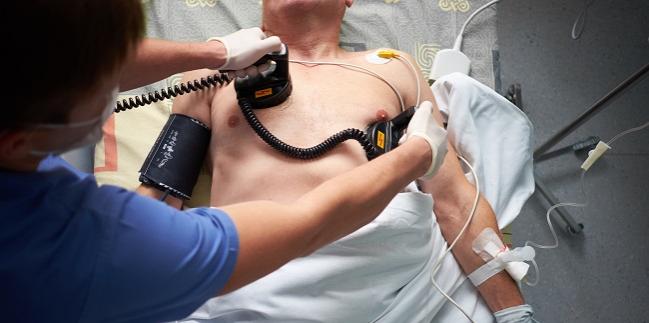Upswing Seen in US Adult and Pediatric In-Hospital Cardiac Arrests
Whether the rise is due to better data collection or increasing incidence is unclear, the study’s senior author says.

Adult and pediatric in-hospital cardiac arrests in the United States are nearly as common as out-of-hospital cardiac arrests, according to a new analysis of registry data gathered between 2008 and 2017. Cardiac arrest in the hospital setting also appears to be on the rise, increasing by 38% in adults and (for pulseless cases) by 18% in children compared with prior reports.
Published July 9, 2019, in Circulation: Cardiovascular Quality and Outcomes, the study found that overall there are approximately 292,000 adult in-hospital cardiac arrests annually in the United States. Prior numbers from 2003 to 2007 had suggested that 211,000 such events occurred each year.
For pediatric patients, the latest annual estimate is 15,200 in-hospital cardiac arrests: 7,100 pulseless and 8,100 that required cardiopulmonary resuscitation for poor perfusion but without loss of pulse. While the incidence of pulseless pediatric events is higher than the previously reported 6,000 events per year, the overall incidence of pediatric in-hospital cardiac arrests (which includes nonpulseless events) did not change.
Lars W. Andersen, MD (Aarhus University Hospital, Denmark), and colleagues extrapolated their results from data voluntarily submitted to the American Heart Association (AHA) Get With The Guidelines–Resuscitation registry by 398 participating hospitals in the United States. The registry tracks in-hospital cardiac arrests among patients without a do-not-resuscitate order.
There’s also a lot of patients where it’s sudden and not their time yet, or at least it shouldn’t be their time yet. Lars W. Andersen
“We had a larger sample size, so we included more hospitals,” Andersen explained to TCTMD as the point of divergence between this work and prior analyses. This larger sample, in Andersen’s view, provides better estimates of the actual number of in-hospital cardiac arrests as well as less uncertainty about the validity of these figures.
That said, such data are inherently slippery. “Either there’s an actual increase in the number of cardiac arrests, or because we are getting better and better at registering these cardiac events we [saw] an increase. Unfortunately, we couldn’t answer that more precisely with the data we had,” Andersen noted.
Not Necessarily ‘Hopeless Prognosis’
Beyond the increases noted above, “the results suggest that in-hospital cardiac arrest occurs with nearly the same frequency as out-of-hospital cardiac arrest. When combining [our analysis] with the previously reported out-of-hospital cardiac arrest incidence of 347,300 adult and 7,000 pediatric cases, the total burden of cardiac arrest reaches approximately 640,000 adult and 22,000 pediatric index cases annually in the United States,” the researchers note in their paper. Hospital training programs--such as the Basic Life Support and Advanced Cardiovascular Support courses offered by the AHA—generally focus on responding to out-of-hospital cardiac events.
“Some of these patients are really, really sick and are maybe terminal, and it’s sort of a natural thing to have a cardiac arrest in the hospital,” Andersen observed. “But there’s also a lot of patients where it’s sudden and not their time yet, or at least it shouldn’t be their time yet.”
In 2013, the AHA issued a consensus statement about how to improve survival for patients who experience an in-hospital cardiac arrest that includes numerous strategies for preventing these events, handling them as they occur, and treating patients after they are over. Healthcare providers often assign such patients a “hopeless prognosis,” the document notes, with its authors hypothesizing that this mindset “may breed impatience and early withdrawal of life-sustaining therapy.”
Marcus A. Banks is the 2019 recipient of the Jason Kahn Fellowship in Medical Journalism. He is currently a master’s…
Read Full BioSources
Holmberg MJ, Ross CE, Fitzmaurice GM, et al. Annual incidence of adult and pediatric in-hospital cardiac arrest in the United States. Circ Cardiovascular Qual Outcomes. 2019;12:e005580.
Disclosures
- Andersen reports no relevant disclosures.


Comments